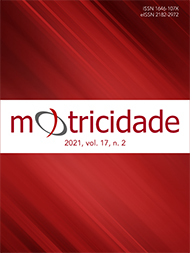Analysis of instruction in youth training with handball coaches
DOI:
https://doi.org/10.6063/motricidade.19240Keywords:
coach behavior, T-patterns detection, feedback, handballAbstract
The way the coach intervenes in training is extremely important for the players and team development. Thus, we intend to analyze the intervention of 3 coaches of young handball in the training process. The coaches hold the professional title of coach level I (n= 2) and level II (n= 1), assigned by the Sport and Youth Portuguese Institute, were handball practitioners; two have a degree in Physical Education and were observed in 3 training sessions. The observational instrument used is the Pedagogical Intervention Analysis System on the Content of the Handball Coach (SAIPCTA). The LINCE® software was used to code the instructional behavior. For data descriptive statistical analysis IBM SPSS Statistics® and the computer program THEME 6®, for the T-patterns detection were used. The coaches observed preferably issue technical information, emit a lot of non-specific information, prescriptive feedback, positive evaluative, and encouragement. The form of preferential instruction is auditory and directed to the individual. In conclusion, the observation of the coaches raises some questions about the effectiveness of the strategies adopted in the training process, which should be the subject of reflective practice.
KEYWORDS: coach behavior; T-patterns detection; feedback; handball.
Downloads
Published
Issue
Section
License
The authors of submitted manuscripts must transfer the full copyright to Journal Motricidade / Sílabas Didáticas Editions. Granting copyright permission allows the publication and dissemination of the article in printed or electronic formats, and copyrights start at the moment the manuscript is accepted for publication. It also allows Journal Motricidade to use and commercialise the article in terms of licensing, lending or selling its content to indexation/abstracts databases and other entities.
According to the terms of the Creative Commons licence, authors may reproduce a reasonable number of copies for personal or professional purposes, but without any economic gain. SHERPA/RoMEO allows authors to post a final digital copy (post-printing version) of the article on their websites or on their institutions' scientific repository.


